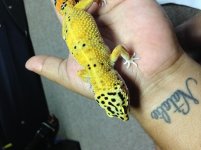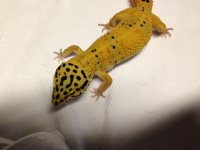You are using an out of date browser. It may not display this or other websites correctly.
You should upgrade or use an alternative browser.
You should upgrade or use an alternative browser.
Puffy arm pit pockets...?!?
- Thread starter LeoCrazy89
- Start date
cricket4u
New member
Hi,
Well this came up at a convenient time. It's not deadly at the moment, however, it came have deadly consequences in years to come. This question comes up so often that I saved this thread.
It's not deadly at the moment, however, it came have deadly consequences in years to come. This question comes up so often that I saved this thread.
http://www.geckosunlimited.com/comm...ros-pics/63910-bubbles-3-4-month-old-leo.html
Interestingly one of the members mentioned this yesterday. I held back my thoughts so that I won't come off as a snob, but I think it's best that I share my thought.
Why have I never bothered to recommend a vet visit for testing? A large % of lymph is made up of protein molecules, therefore the fluid will always come back as protein rich.:biggrin:
Leocrazy89 your leo is overweight as well. Some adjustments must be done. Can you provide full details?
diet, temperatures, supplement names, pictures of the enclosure, age
Well this came up at a convenient time.
http://www.geckosunlimited.com/comm...ros-pics/63910-bubbles-3-4-month-old-leo.html
Interestingly one of the members mentioned this yesterday. I held back my thoughts so that I won't come off as a snob, but I think it's best that I share my thought.
Why have I never bothered to recommend a vet visit for testing? A large % of lymph is made up of protein molecules, therefore the fluid will always come back as protein rich.:biggrin:
Leocrazy89 your leo is overweight as well. Some adjustments must be done. Can you provide full details?
diet, temperatures, supplement names, pictures of the enclosure, age
Last edited:
Mardy
New member
There are different schools of thought on this. You should research on it and decide who you want to believe. One take is that the armpit is where leopard geckos store excess protein and other minerals, and tail is where they store excess fat. If you see these bubbles, it means your gecko is being a bit overfed. It's quite obvious as your gecko seems to have one of those balloon tails. The best thing to do is to simply cut down on feeding fatty feeders, and provide a better variety of low fat feeders. Also don't spoil your gecko too much by feeding them so much, as pet owners are often guilty of. If you cut down on what they eat, and start offering low fat feeders more often, you should see the bubbles go down slowly over time.
The armpit bubbles usually come and go often with seasonal changes. Like right now, the breeding season is over and females should be gorging as you may have noticed. All of my female breeders are pigging out. Their instinct is to eat as much as they can to replenish their weight loss from the breeding season, so they can better prepare for the next breeding season which is coming up in 4 short months. So for breeders, we often don't worry about these armpit bubbles as the bubbles go away during the breeding season as the females use up their body fat while fasting, and they use up excess nutrients when producing eggs. If you are a breeder, and you'll be using that female to breed soon, then the armpit pockets are of no concern. If you are a hobbyist, or you aren't going to be using that female for breeding purposes, then you should cut back on feeding, and start providing a more low fat variety diet.
The above are the findings and recommendations of vets and herpetologists, so again I'm just a messenger spreading these hard to find information. I say hard to find because some of the info I dug up a couple of years ago came from a forum that no longer exist. It was when a well known long time breeder consulted with a renowned herpetologist & vet on this and they came the conclusion above. People are welcome to challenge it and give their own take on it. But I find their explanation much better than folks randomly calling them calcium bubbles.
The armpit bubbles usually come and go often with seasonal changes. Like right now, the breeding season is over and females should be gorging as you may have noticed. All of my female breeders are pigging out. Their instinct is to eat as much as they can to replenish their weight loss from the breeding season, so they can better prepare for the next breeding season which is coming up in 4 short months. So for breeders, we often don't worry about these armpit bubbles as the bubbles go away during the breeding season as the females use up their body fat while fasting, and they use up excess nutrients when producing eggs. If you are a breeder, and you'll be using that female to breed soon, then the armpit pockets are of no concern. If you are a hobbyist, or you aren't going to be using that female for breeding purposes, then you should cut back on feeding, and start providing a more low fat variety diet.
The above are the findings and recommendations of vets and herpetologists, so again I'm just a messenger spreading these hard to find information. I say hard to find because some of the info I dug up a couple of years ago came from a forum that no longer exist. It was when a well known long time breeder consulted with a renowned herpetologist & vet on this and they came the conclusion above. People are welcome to challenge it and give their own take on it. But I find their explanation much better than folks randomly calling them calcium bubbles.
cricket4u
New member
Mardy it's a build up of lymph fluid in soft tissue, not normal or healthy. It is caused by excess and/or obesity. It should be prevented. This puts tremendous strain on their heart and other organs. You will have to be careful with anything in excess and make sure you're providing proper temperatures. Both my males and female are willing to pig out all the time f I allowed it.
Last edited:
Mardy
New member
Well looks like we both agree that it's a sign of obesity and overfeeding, that's good to know 
As for your geckos' behaviors, it's completely normal for your geckos to behave differently as you don't breed them, they probably don't even know other sexes exist around them. For breeders like me, with my tank setup and racks, all the males know when the females are ready as tail rattling can be heard randomly throughout the night even with the males being housed alone. It's quite funny really. I have no doubt the females also catch the male's scent. So the cycles I see every year with my geckos are most definitely going to be different from what you would see with yours, nothing wrong with that. I have select males & females that would fast for months at a time during the breeding season, every year. And by July/August they are all eating normally, every year. I know that type of behavior isn't going to happen with your setup, so it's completely normal for different folks to see different things.
I know LeoCrazy89 above breeds, or he's starting to, that's why I gave him some breeder advice on gecko's yearly cycles.
As for your geckos' behaviors, it's completely normal for your geckos to behave differently as you don't breed them, they probably don't even know other sexes exist around them. For breeders like me, with my tank setup and racks, all the males know when the females are ready as tail rattling can be heard randomly throughout the night even with the males being housed alone. It's quite funny really. I have no doubt the females also catch the male's scent. So the cycles I see every year with my geckos are most definitely going to be different from what you would see with yours, nothing wrong with that. I have select males & females that would fast for months at a time during the breeding season, every year. And by July/August they are all eating normally, every year. I know that type of behavior isn't going to happen with your setup, so it's completely normal for different folks to see different things.
I know LeoCrazy89 above breeds, or he's starting to, that's why I gave him some breeder advice on gecko's yearly cycles.
Last edited:
LeoCrazy89
New member
Age: 8 months/. Housing: 20 gallon long/Moist hide/warm hide/cool hide/UTH set on 92f. Dusted meal/crickets 4x's a week with Reptivite and a dish of Reptile-Calcium w/o D3 in the tank
cricket4u
New member
Age: 8 months/. Housing: 20 gallon long/Moist hide/warm hide/cool hide/UTH set on 92f. Dusted meal/crickets 4x's a week with Reptivite and a dish of Reptile-Calcium w/o D3 in the tank
Air temp on both sides? Thermostat?
About how many crickets and mealworms are you feeding daily?
How often is she fed?
A picture of the enclosure?
What gut load?
I will tell you this ahead of time. If you are dusting several insects at each feeding 4x's a week with Reptivite with d3, it's a bit too much.




